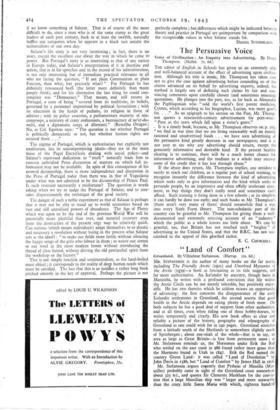" Land of Comfort II/
Greenland. By Vilhjalmar Stefansson. (Harrap. 128. 6d.) MR. STEFANSSON is the author of many books qn the far north, including The Friendly Arctic (1921) and Unsolved Mysteries of the Arctic (Ii39)—a book as fascinating as its title suggests, and far more authoritative. An Icelander by ancestry, though born in Manitoba, he writes with a profound conviction that life within the Arctic Circle can be not merely tolerable, but positively enjoy- able. He has two theories which he seldom misses an opportunity of advancing : the first concerns the disappearance of the early Icelandic settlements in Greenland, the second asserts that good health in the Arctic. depends on eating plenty of fresh meat. On both subjects he has a good deal of support from other authorities, and at all times, even when riding one of these hobby-horses, he writes temperately and clearly. His new book offers as clear and reliable a picture of the history, geography and ethnography of Greenland as one could wish for in 240 pages. Greenland stretches from a latitude' south of the Shetlands to somewhere slightly north of Spitzbergen ; about one-sixth of the whole—that is to say, an area as large as Great Britain—is free from permanent snow ; as Mr. Stefansson reminds us, the Norsemen under Erik the Red who settled on the east coast in 986 found rather more grass than the Mormons found in Utah in 1847. Erik the Red named the country Green Land : it was called " Land of Desolation " by John Davis in 1586, but "Land of Comfort" by James Hall in i•SA Mr. Stefansson. argues cogently that Pytheas of Massilia (Mar- seilles) probably came in sight of the Greenland coast somewhere about 325 B.C., and quotes Sir Clements Markham for the convic- tion that a large Massilian ship was " larger and more seaworthy than the crazy. little Santa Maria with which, eighteen hundred years afterwards, Columbus discovered the New World." But was Pytheas the first European to see Greenland, and was Columbus the first discoverer of the New World ? Mr. Stefansson is inclined to think not. The Irish in their curraghs certainly reached Iceland very early in Ale history of exploration—perhaps earlier than Pytheas—and Dicuil talks of a party of Irish monks reaching frozen sea a day's sail beyond Iceland, which could bring them well within sight of Greenland. And where was the coast which Leif, son of Erik the Red, named " Vinland " when he -landed there in A.D. I000 and discovered " wineberries," " self-sown wheat " and various kinds of trees, including maples ? Mr. Stefansson, giving reasons to believe that the Icelandic word Sudar meant south-west rather than south, .makes his own contribution to what he rightly calls " the voluminous, tangled and on the whole fruitless Vinland controversy."
On the more recent exploration of Greenland—the decay of the Icelandic settlements, the voyages of Frobisher, Davis, Hall, Hudson and Baffin, Egedes' search for the last settlements in the eighteenth century, and then the charting of the North and West Coasts— Mr. Stefansson writes clearly and vividly, and towards the end of his book he gives an account of the economy of modern Greenland. In 194o, the total population was 17,50o, of whom Soo were Europeans. The principal exports included marble and cryolite ; the principal imports, apart from ammunition and hunting imple- ments, were tobacco and coffee. Finally, Mr. Stefansson discusses the strategic importance of the country : " If the Germans are on the Inland Ice then they are keeping it a secret : if our side has discovered the Germans up there then we have not yet been told of it." It would certainly not be physically impossible for the Germans, using air transport, to establish a meteorological station in Greenland and send reports back by beam-wireless via Spitzbergen.
MICHAEL ROBERTS.



























 Previous page
Previous page